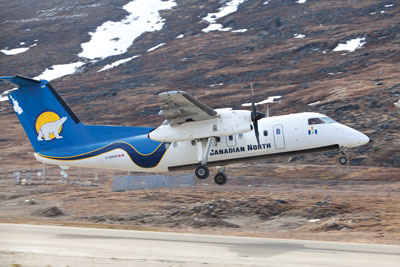
News
On Final: Time for an infrastructure infusion
When people think of the challenges in running an airline, they often focus on the obvious aspects: which aircraft types and how many of each they should have, the maintenance of the aircraft, pilots and their training, and more. However, for air carriers operating in northern and remote regions of Canada, sometimes this is the easy stuff
March 6, 2013 By Stephen Nourse
When people think of the challenges in running an airline, they often focus on the obvious aspects: which aircraft types and how many of each they should have, the maintenance of the aircraft, pilots and their training, and more. However, for air carriers operating in northern and remote regions of Canada, sometimes this is the easy stuff – at least the relatively known and somewhat predictable stuff.
 |
|
| Here, aircraft serve as the local bus, the delivery truck to the store, and the ambulance PHOTO: Canadian North
|
Mention the challenges of northern aviation and most people add to the above snow, extreme cold weather, long periods of darkness, and flying on floats or skis. However, the reality is once you move north, away from the 49th Parallel and the 26 airports in the National Airports System, you enter a brave new world. It’s a world where the norm transitions to shorter, often gravel, runways, limited navigational aids, shorter hours of weather observations, sometimes minimal fuel supplies, a quantum increase in cost, and yes, long, cold, dark winters.
Perversely, these also tend to be locations where the communities served are virtually completely dependent on air travel as there is no other year-round mode of transportation available to them. Here, aircraft serve as the local bus, the delivery truck to the store, and the ambulance.
So, what are air carriers looking for to assist them in providing safe, efficient, and cost-effective service in these areas? Simply put, infrastructure and not more regulatory requirements based on southern perspectives. For example:
- Don’t mandate Runway End Safety Areas (RESA) in remote areas based on international aviation standards at a cost of hundreds of millions of dollars, or worse, shorter runways to get low-cost compliance. Instead, put that money where it will actually increase safety and help prevent accidents. Better approach lighting, improved navigational aids, more modern GPS approaches, longer runways where practical, and 24-hour weather services will all contribute to getting aircraft safely on the runway rather than just minimize damage to it past the end of the runway.
- Don’t impose flight-and-duty time restrictions on small operators based on union agreements with large international carriers and European flying conditions. Should some changes be made based on current fatigue science? Yes, but only when also properly taking into account unique Canadian operating conditions.
- Provide more pavement. A significant number of runways serving the smaller, and some not so small, communities remain gravel surfaced. This not only increases operating cost due to aircraft damage but it also greatly limits the types of aircraft that can be utilized – again increasing cost.
- Provide longer runways. In addition to being gravel, most of the northern strips are also short: 1,200 metres or less. This further limits the availability of new aircraft types that can properly serve these airports. Most of the new-generation aircraft suitable for the smaller markets need 1,520 metres as a minimum standard.
Of course a lot of this takes money – money that northern and remote communities simply do not have. All three territories combined have only about 110,000 people, or about the same population as a southern mid-sized city such as Kingston, Ont. If the Harper government is truly committed to northern sovereignty and infrastructure improvement then it needs to step up to the plate. The present federal Airport Capital Assistance Program (ACAP), although beneficial, is limited in both total available funds and in what qualifies for funding. Typically, items such as initial paving, runway extensions, terminals, fuel storage, and weather reporting systems do not qualify.
Given the strategic and social importance of airport infrastructure in the north, serious consideration must be given to a supplemental program, or a northern ACAP. It should be a program that can assist in upgrading these areas to a standard that will allow air carriers to use newer, more fuel-efficient aircraft and provide to the communities reliable all weather service they deserve.
In short, it’s time to provide the necessary and appropriate infrastructure and don’t burden the north with well intentioned, but inappropriate, regulations.
When this does happen, northern carriers will not only be able to continue providing safe and efficient service under challenging conditions, but they will also be able to improve it.
Stephen Nourse is the executive director of the Northern Air Transport Association